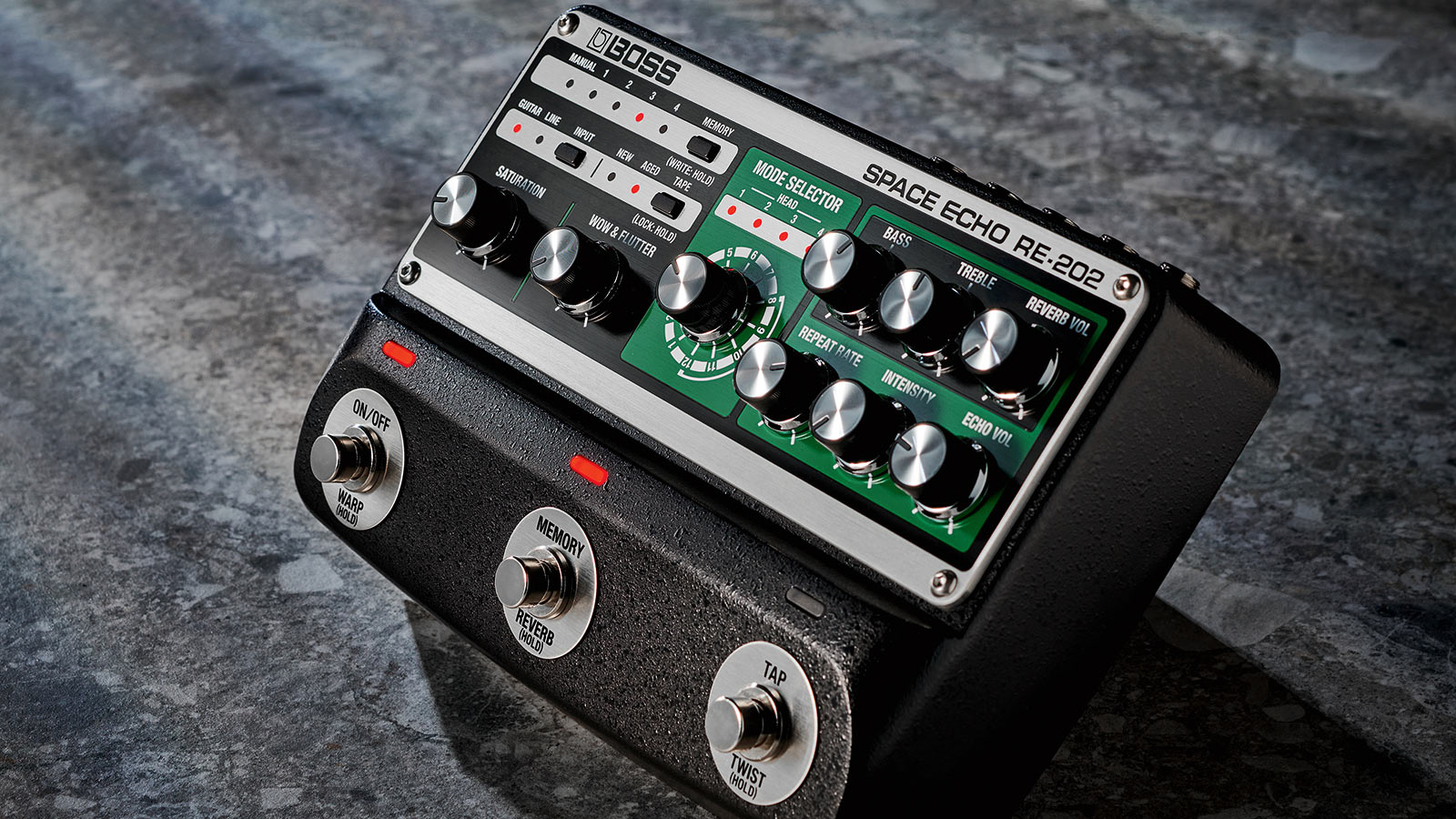Guitar World Verdict
Boss has got this just right: the RE-202 accurately reproduces Space Echo sound while going way beyond the capabilities of an original Roland RE-201.
Pros
- +
Accurate recreation of RE-201 sound.
- +
Fourth head.
- +
Tap tempo, memories.
- +
Flexible hands-on sound adjustment.
- +
Expression pedal capability.
Cons
- -
Certain global functions (such as dry sound mute, reverb type, tails and so on) are a little convoluted to set up.
You can trust Guitar World
Roland’s multi-head tape echo has become the stuff of legend – as our recent retrospective on the RE-201 explored.
The company knew that such an important machine deserved to be celebrated in a delay pedal and came up with the Boss RE-20 around 15 years ago. However, technology moves on and the time was ripe to revisit the Space Echo, with new advancements allowing a deeper delve into its complex non-linear behaviour.
Boss says that everything that influences the sound was carefully examined and recreated with new algorithms, the result being not one but two new pedals: the triple-footswitch RE-202 we have on test here, and the RE-2, which comes in standard Boss compact pedal form – still sonically potent but missing some of its sibling’s features.
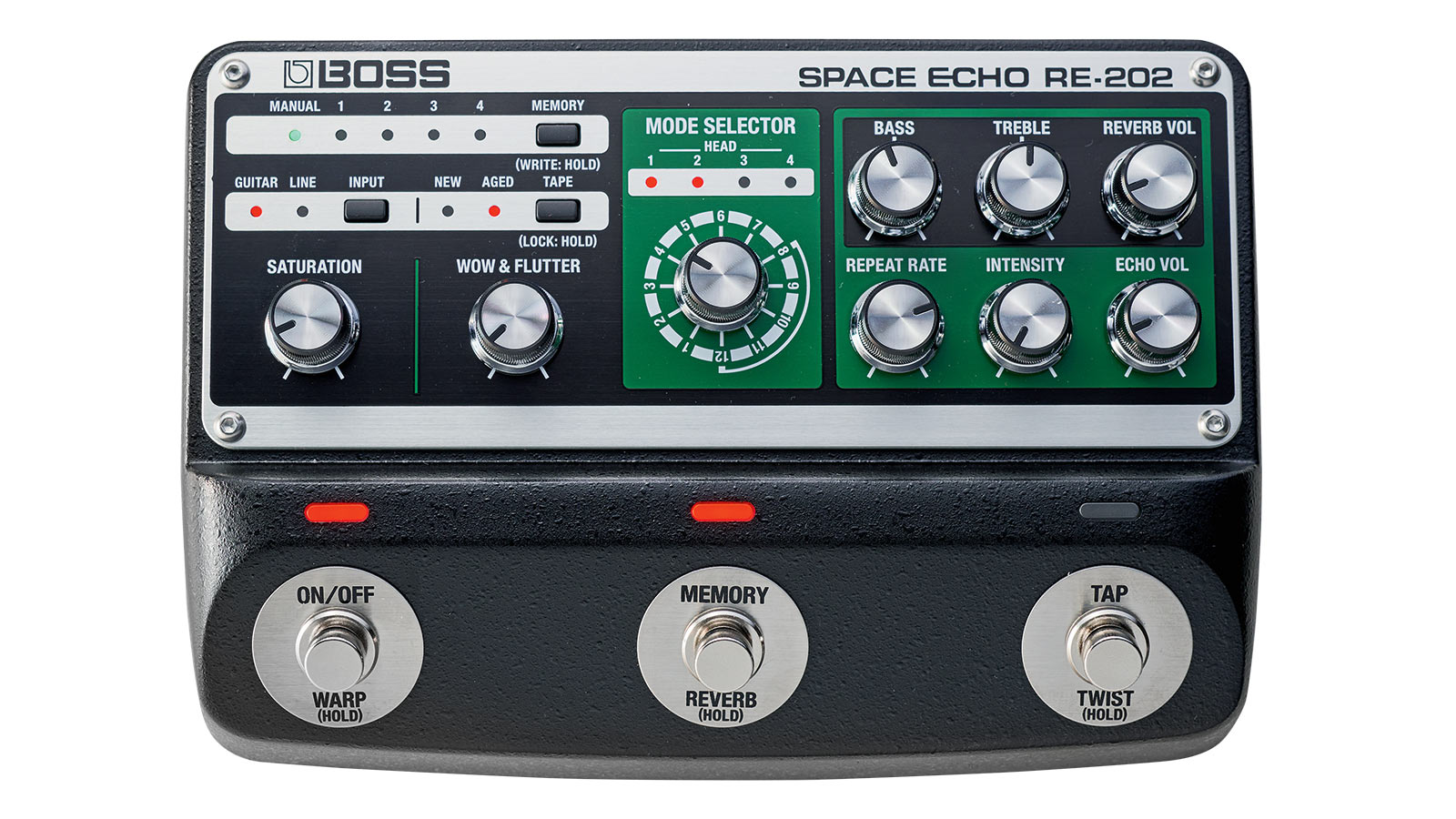
The RE-202 is about the size of two and a half Boss compact pedals set side by side and features a curvy chassis shape that gives a nod to the earliest Boss pedals, such as the CE-1, DM-1 and DB-5. Offering stereo as well as mono connection, the right side of the RE-202’s control surface mirrors the exact knob layout of an RE-201 with a 12-position rotary mode selector to choose the head combinations.
Sonic characteristics that you’d have little or no control over in an original machine can be zeroed in on here to get the exact sound you want with consistency
This new version differs from the original, however, by having four virtual heads, rather than three. Where the modes on the RE-201 offered four different head options without reverb, seven with reverb and one reverb-only mode, this one provides seven modes offering all the various options for the first three heads singly and in combination, plus a further five modes that incorporate the fourth head. Reverb can be independently added to all 12 simply by turning up the Reverb Volume knob.
By contrast, the smaller RE-2 only has three virtual heads and has 11 modes that match the RE-201’s echo modes (with reverb on only modes 5 to 11). In its default Normal mode the RE-202 has the same Repeat Rate (delay time) range as an RE-201 and a maximum value for the tap tempo of one second, but there is a Long mode (with a two second tap tempo), and the extended delay time increases options beyond a purely vintage experience.

Sounds
Part of the sonic profile of a tape echo is obviously due to the idiosyncrasies of the tape medium and its transport mechanism. The RE-202 gives you access to a range of parameters that mimic these, meaning that certain sonic characteristics that you’d have little or no control over in an original machine can be zeroed in on here to get the exact sound you want with consistency.
For example, you can set the RE-202 to sound like a machine where the tape is pristine or one where the tape is well used and exhibits duller tone. The waywardness of the sound is caused by small fluctuations in tape speed due to the state of the transport mechanism, and this can be adjusted with the Wow & Flutter knob, which adds a realistic characteristic swimminess, but it can get further into pitch modulation like a machine that’s out of kilter, or just for effect.
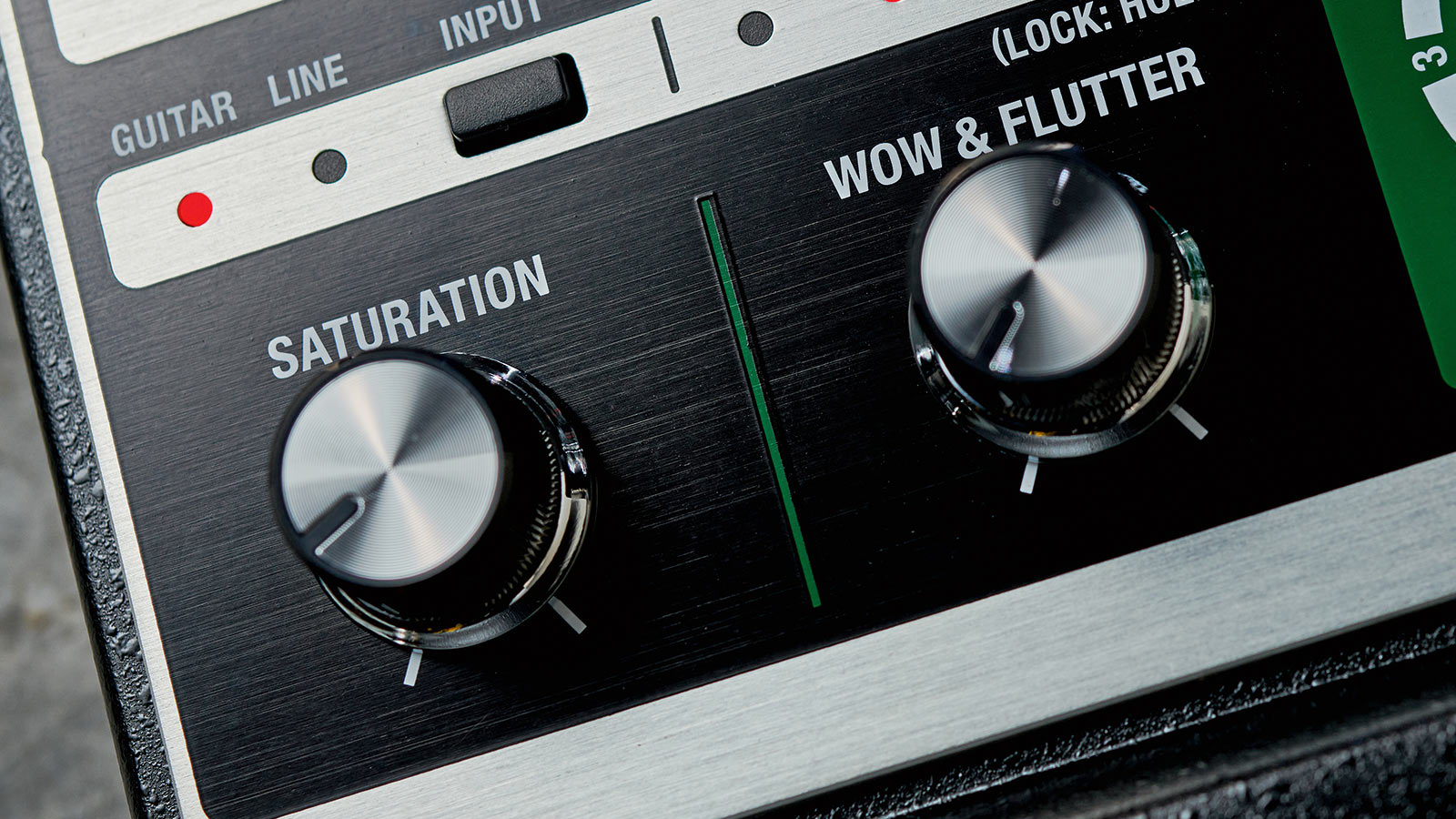
The preamp in an original machine contributes to sonic character, particularly when driven hard, adding compression and distortion – and this is reproduced here by the Saturation knob, which is great for thickening and dirtying the repeats. You have the option of preamp emulation either being switched in with the echo effect or always on, contributing to your overall tone even when the echo is bypassed.
It’s extremely useful to have four presets onboard to save favorite sounds, but the RE-202 actually supports 127 memories
In this case, the Saturation knob will turn up the juice on both the repeats and the dry sound. Besides these, the Bass and Treble knobs provide a practical range of adjustment, aiding sculpting the repeats to blend perfectly with your playing.
The reverb here is an accurate simulation of the short spring found in an RE-201, but if you’d prefer something different from its somewhat boxy nature, then there are Hall, Room, Plate and Ambience options. With plenty of adjustable parameters, it’s extremely useful to have four presets onboard to save favorite sounds, but the RE-202 actually supports 127 memories accessible via MIDI program change.
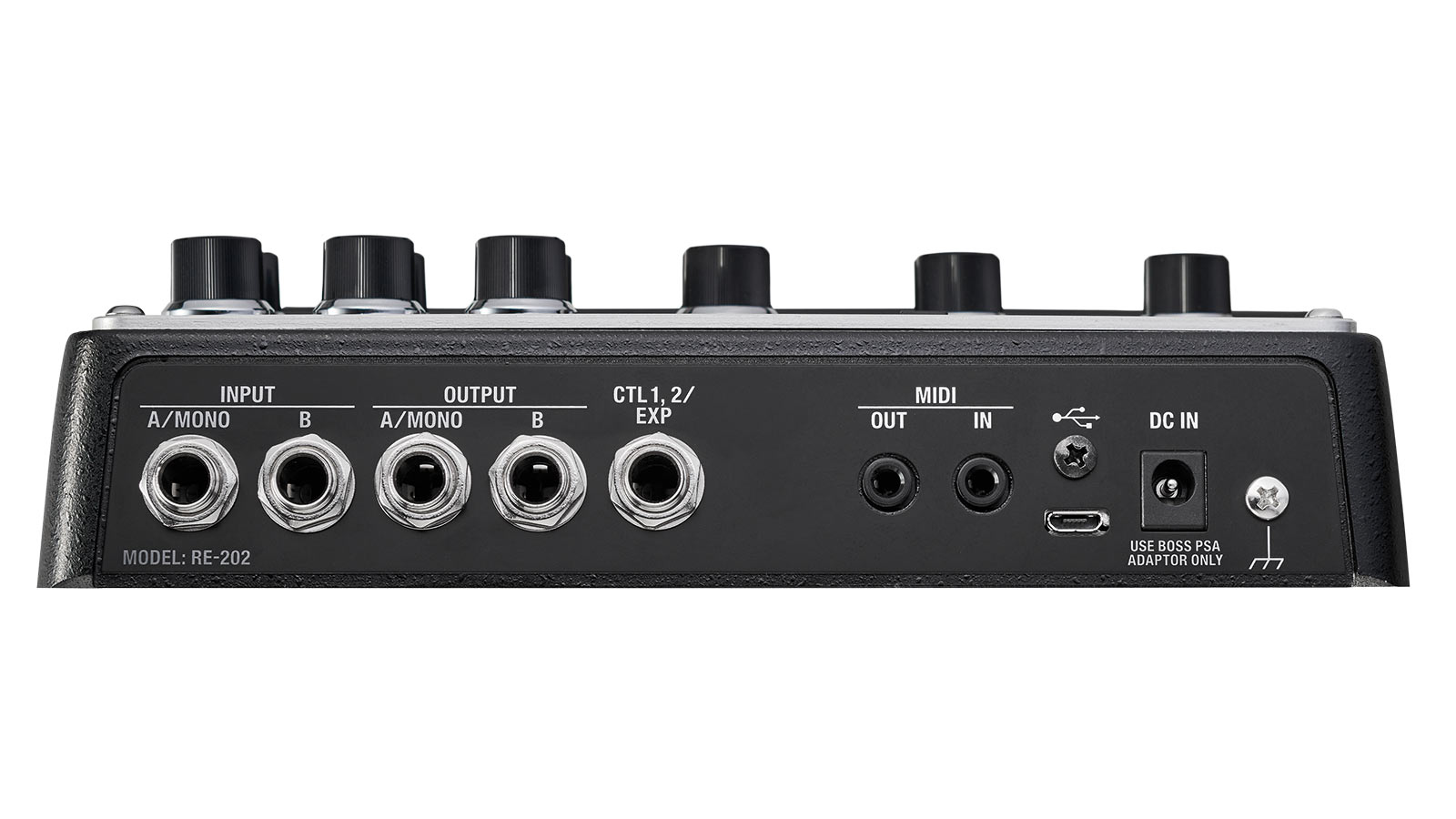
Given the 40-plus years of use our original RE-201 has clocked up and the inherent differences between electro-mechanical randomness and digital consistency, we weren’t expecting the RE-202 to sound identical to it in an A/B test.
But it actually nailed the sound – we were able reproduce everything the RE-201 was capable of, apart from the occasional random glitches, which presumably no-one would want, where the tape momentarily slowed down before catching up to speed (admittedly our RE-201 hasn’t been serviced in a while!).
The single-head echoes all do their job wonderfully, covering plenty of playing applications, such as slapback, but it’s the combinations that make a multi-head machine special with the complexity of its rhythmic patterns.
For real performance versatility you can connect an expression pedal assigned to one or multiple parameters
Those here sound great as the repeats bounce around and drift off naturally into the distance – and the fourth head is a real bonus, delivering patterns you wouldn’t get using an RE-201. Mode 12, for example, with all four heads engaged (incidentally with altered head spacing), offers a certain dense ambience.
While the main functions of the three footswitches are for bypass, selecting presets and tap tempo, they each have a secondary performance function when pressed and held. The middle footswitch can be used to bring the reverb in and out within your active effect, while the other two offer similar effects to those you’d get by twisting knobs in real-time.
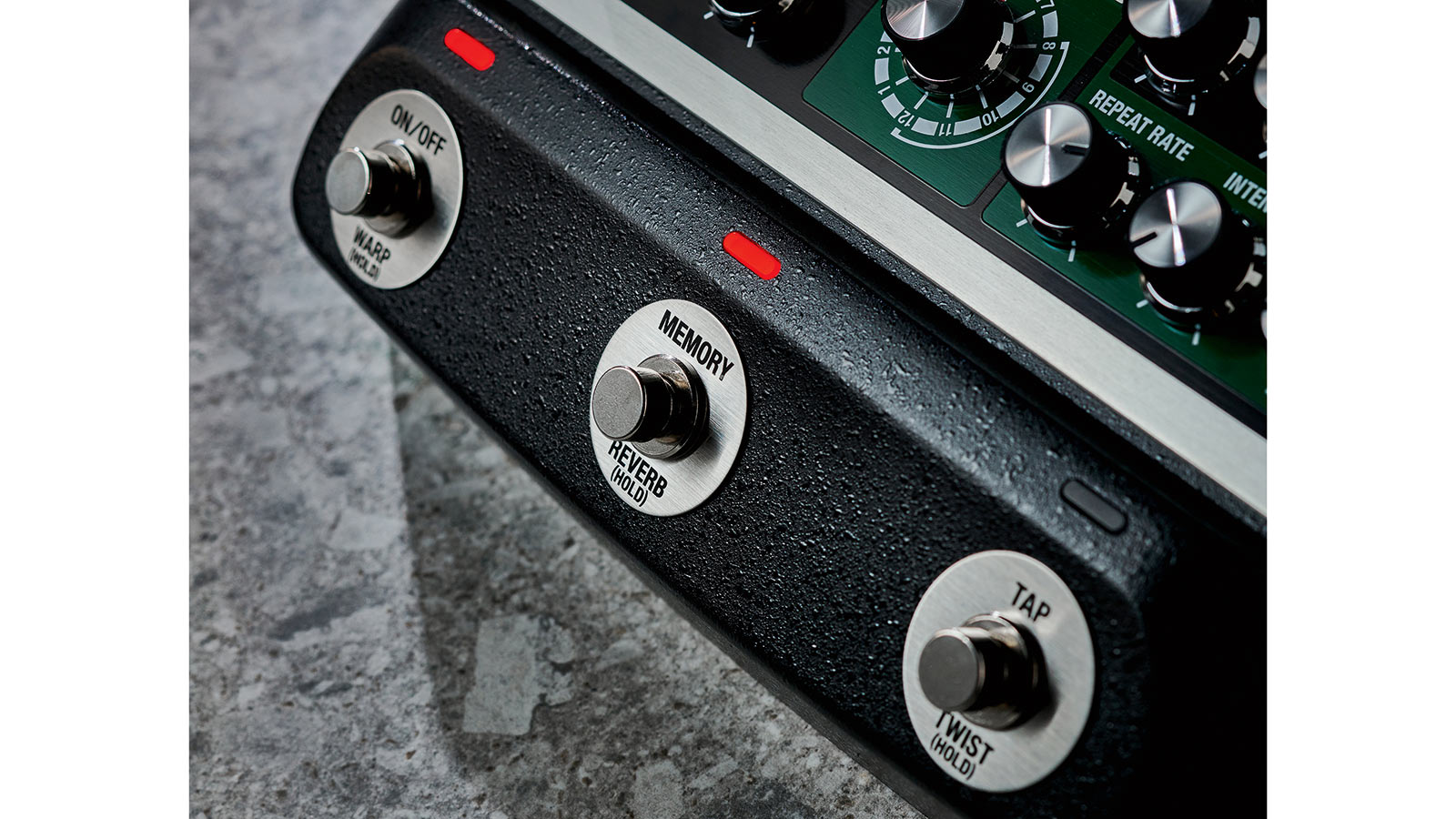
The Twist effect is the equivalent of turning up the repeat rate, while the Warp effect is like turning the Intensity (feedback) up. Both ramp back down when you release the footswitch.
They are fun, but for real performance versatility you can connect an expression pedal assigned to one or multiple parameters – for example, giving nuanced control over ramping up the feedback into self-oscillation.
Verdict
Boss has got this just right: the RE-202 accurately reproduces Space Echo sound while going way beyond the capabilities of an original Roland RE-201. If you’ve ever wished to have a Space Echo in your rig but thought it impractical, now you can do it with total confidence.
Specs
- PRICE: $419 / £339
- ORIGIN: Malaysia
- TYPE: Delay pedal
- FEATURES: Buffered bypass, 12 modes, 127 memories plus manual, tap tempo, tails carry over, dry mute option
- CONTROLS: Mode selector, Bass, Treble, Reverb Volume, Repeat Rate, Intensity, Echo Volume, Saturation, Wow & Flutter, Guitar/Line button, New/Aged Tape button, Memory button, Bypass footswitch, Memory footswitch, Tap footswitch
- CONNECTIONS: Standard inputs (A/Mono, B), standard outputs (A/ Mono, B), CTL/Exp pedal input, MIDI In, MIDI Out, USB (for updates)
- POWER: Supplied 9VDC Boss PSA adaptor 500mA (unit current draw: 140 mA)
- DIMENSIONS: 192 (w) x 133 (d) x 52mm (h)
- CONTACT: Boss
Trevor Curwen has played guitar for several decades – he's also mimed it on the UK's Top of the Pops. Much of his working life, though, has been spent behind the mixing desk, during which time he has built up a solid collection of the guitars, amps and pedals needed to cover just about any studio session. He writes pedal reviews for Guitarist and has contributed to Total Guitar, MusicRadar and Future Music among others.
“The original Jordan Boss Tone was probably used by four out of five garage bands in the late ’60s”: Unpacking the gnarly magic of the Jordan Boss Tone – an actual guitar plug-in that delivers Dan Auerbach-approved fuzz
“This is a powerhouse of a stompbox that manages to keep things simple while offering endless inspiration”: Strymon EC-1 Single Head dTape Echo pedal review
